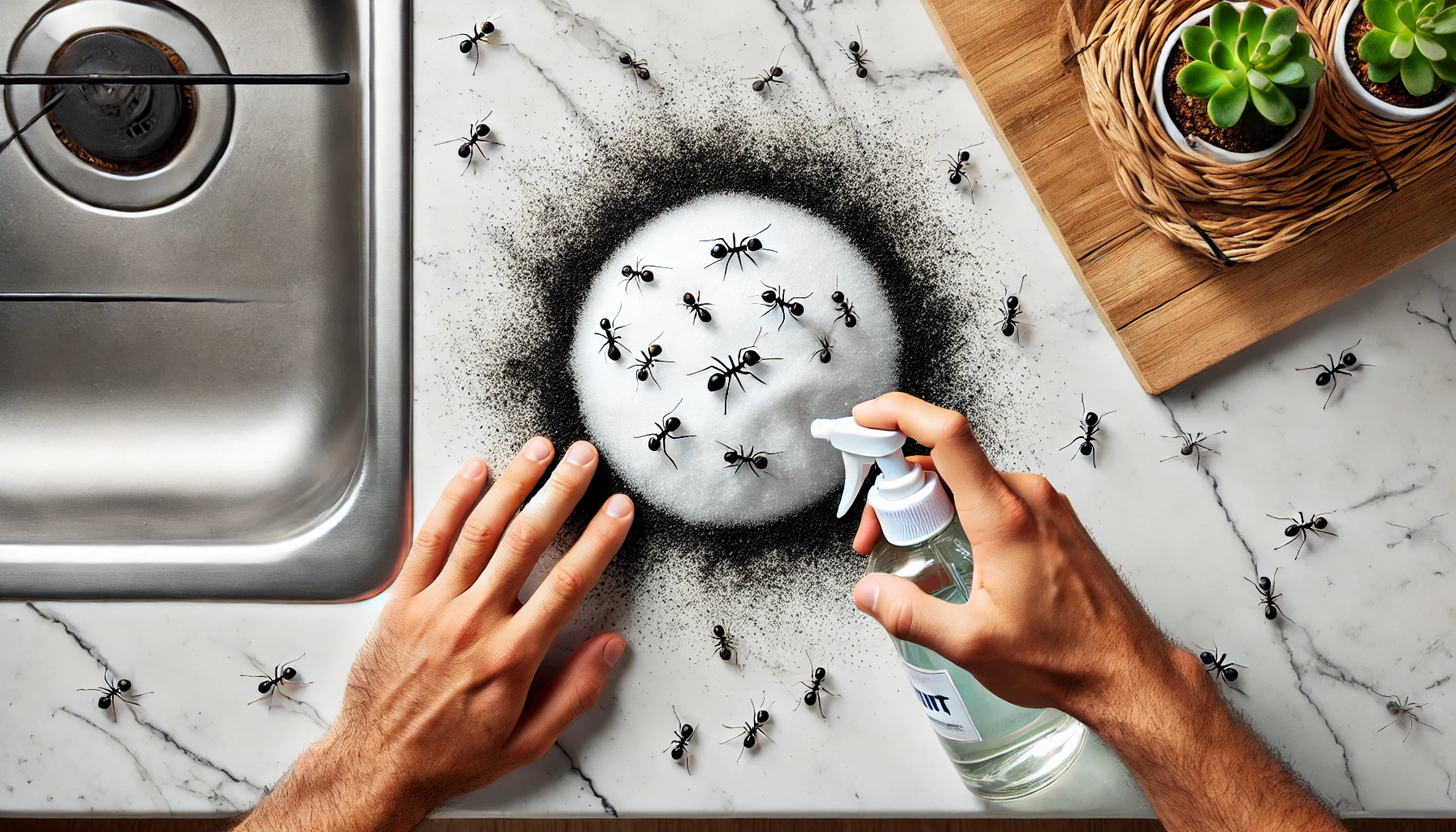Tiny black ants in your kitchen can be a frustrating problem. These ants often appear in search of food and water, quickly turning a small infestation into a big nuisance. They leave pheromone trails that guide more ants to the source, making it essential to act fast.
In this guide, we will walk you through step-by-step methods to eliminate tiny black ants from your kitchen. We will cover everything from identifying their entry points to using natural and chemical repellents. By following these steps, you can get rid of these pests and prevent them from returning.
Introduction
Why Are There Tiny Black Ants in Your Kitchen?
Ants are naturally drawn to food, especially sweet or greasy substances. Kitchens provide an ideal environment for ants due to crumbs, spills, and access to water. Even if you clean regularly, tiny gaps in doors and windows allow ants to enter.
Ants use pheromone trails to communicate with other members of their colony, signaling where to find food. Once an ant discovers a source, it won’t take long for others to follow. Additionally, certain weather conditions—such as heavy rain—can drive ants indoors seeking shelter.
Are Tiny Black Ants Dangerous?
While tiny black ants are not directly harmful to humans, they can contaminate food and kitchen surfaces. Some species, like the odorous house ant, release a foul smell when crushed. Others, like carpenter ants, can damage wooden structures if left unchecked.
In rare cases, ants may introduce bacteria from unsanitary areas into your home. This makes it crucial to eliminate them as soon as you notice their presence.
Step 1: Identify the Source of the Ants
The first step in getting rid of tiny black ants is identifying their source. You need to determine why they are entering your kitchen, where they are coming from, and what type of ants you’re dealing with. Understanding these factors will help you choose the most effective removal strategy.
1.1 Understand Why Ants Invade Your Kitchen
Ants are opportunistic scavengers that seek out food and water sources. They can detect even the smallest crumbs or spills and will travel long distances to collect them. Most ants are attracted to sugar, grease, and protein-based foods.
Common Reasons Ants Are Attracted to Your Kitchen
Your kitchen provides easy access to food and water. Even a minor spill or unsealed food container can attract ants. Additionally, pet food left out overnight is a common culprit. If there are moisture issues, such as leaking pipes, ants may also gather near sinks and drains.
Types of Food That Attract Ants
Ants prefer sugary foods, including honey, fruit, and soda. However, some species are drawn to protein-based foods like meat and peanut butter. Leftover crumbs from bread or chips can also lure them inside. Keeping food sealed and your kitchen clean is crucial in preventing infestations.
1.2 Locate Entry Points
To stop an infestation, you must find out how ants are entering your home. Tiny cracks in walls, gaps in windows, and unsealed doors provide easy access. Ants may also come through plumbing or electrical lines.
Checking Cracks and Crevices
Inspect areas around windows, baseboards, and door frames for cracks. Even the smallest gaps can serve as entry points. Using caulk to seal these openings is an effective way to keep ants out.
Inspecting Doors, Windows, and Pipes
Ants often enter through gaps in doors and windows. Check for damaged seals or gaps where ants could squeeze through. Also, inspect pipes under sinks for leaks, as ants are drawn to moisture.
1.3 Identify the Type of Ants
Different species of ants require different treatment methods. Identifying the type of ant in your kitchen will help determine the best removal strategy.
Common Tiny Black Ant Species in Homes
Some common tiny black ants include odorous house ants, pavement ants, and little black ants. Odorous house ants are often found in kitchens and emit a rotten coconut smell when crushed. Pavement ants typically nest under floors and foundations.
Why Knowing the Species Matters
Some ants prefer sugar, while others are attracted to protein. Knowing which species you are dealing with allows you to choose the right bait or treatment method.
Step 2: Eliminate Ant Trails and Food Sources
Once you’ve identified where the ants are coming from, the next step is eliminating their food sources. Without access to food and water, ants will not survive in your kitchen.
2.1 Clean Thoroughly to Remove Pheromone Trails
Even after you remove visible ants, pheromone trails remain. Cleaning these trails ensures new ants won’t follow the same path.
The Importance of Disrupting Ant Trails
Ants rely on pheromones to navigate. If you don’t remove these trails, more ants will continue to follow them into your kitchen.
Best Cleaning Solutions for Wiping Out Scent Trails
A mix of vinegar and water is highly effective at erasing pheromone trails. You can also use soapy water or commercial disinfectants.
2.2 Store Food Properly
Keeping food sealed is essential in preventing ant infestations.
Best Containers to Keep Ants Out
Use airtight containers for sugar, flour, and other pantry items. Plastic bags are not effective since ants can chew through them.
Where and How to Store Pet Food
Pet food should be stored in sealed containers. Avoid leaving it out overnight, as ants are especially attracted to it.
2.3 Take Out the Trash Regularly
Trash is one of the biggest attractants for ants.
How Improper Garbage Disposal Attracts Ants
Leaving food scraps in open trash bins provides an easy food source. Even small bits of residue in the trash can lure ants.
Best Trash Bins for Keeping Ants Away
Use a trash bin with a tightly sealed lid. Empty the trash regularly to prevent ants from foraging inside.
2.4 Fix Moisture Problems
Ants need water to survive, so eliminating moisture sources helps deter them.
Why Ants Are Attracted to Water
Leaking pipes and damp areas provide hydration for ants. They will establish nests near moisture sources.
Checking for Leaks and Condensation
Inspect under sinks, near appliances, and around windows for moisture buildup. Fixing leaks removes an essential resource for ants.
Read More: how to get rid of sugar ants in kitchen
Step 3: Use Natural and Chemical Ant Repellents
Once you’ve eliminated food sources and sealed entry points, the next step is to actively repel and kill the remaining ants. There are various natural and chemical methods to get rid of tiny black ants in your kitchen. Natural remedies are safer, especially if you have pets or children, while store-bought solutions provide faster results.
3.1 Natural Remedies to Repel Ants
If you prefer to avoid chemicals, several natural repellents can deter ants. These methods use strong scents or substances that disrupt ant trails and discourage them from returning.
Vinegar and Water Solution
A 50/50 mixture of vinegar and water is an effective ant deterrent. Vinegar removes pheromone trails and acts as a natural repellent. Simply spray it along baseboards, countertops, and entry points.
Lemon Juice as an Ant Deterrent
Lemon juice has acidic properties that confuse ants’ navigation. Squeeze fresh lemon juice around entry points and mix it with water to clean floors and surfaces.
Cinnamon, Peppermint Oil, and Other Natural Repellents
Cinnamon, peppermint oil, and cloves have strong scents that ants dislike. Sprinkle cinnamon powder near entry points or mix peppermint oil with water and spray it in affected areas. These methods repel ants without harming them.
3.2 DIY Ant Baits and Traps
Homemade ant baits are an effective way to kill entire colonies. By using a combination of sugar (to attract ants) and toxic ingredients, you can eliminate them at the source.
Using Sugar and Borax to Kill Ants
Mix sugar and borax with water to create a syrup-like bait. Place small amounts on cotton balls and leave them where ants are active. The ants will carry the borax back to the colony, killing them over time.
Making Baking Soda and Sugar Bait
Another alternative is mixing baking soda with sugar. Ants are unable to digest baking soda, which disrupts their digestive system. Place the mixture in shallow dishes around the kitchen.
3.3 Store-Bought Ant Baits and Sprays
For faster results, you can use commercial ant baits and insecticides. These products are designed to attract and kill ants effectively.
Best Commercial Ant Killers for Kitchens
Gel-based ant baits and traps are some of the best options for indoor use. Brands like Terro and Raid offer highly effective solutions that ants carry back to their colony.
How to Safely Use Ant Sprays Indoors
If you choose to use ant sprays, make sure they are labeled safe for indoor use. Avoid spraying directly on kitchen surfaces where food is prepared. Instead, apply sprays near baseboards, entry points, and areas where ants gather.
Step 4: Prevent Future Ant Infestations
Once you’ve successfully eliminated the tiny black ants, it’s crucial to take steps to prevent them from returning. Prevention is key to maintaining an ant-free kitchen.
4.1 Seal Entry Points
Blocking access points is essential to keeping ants out of your kitchen permanently.
Using Caulk to Block Cracks and Gaps
Use silicone caulk to seal cracks in walls, around windows, and along baseboards. This prevents ants from finding new entryways into your home.
Sealing Windows and Doors Effectively
Check for gaps in doors and windows and install weather stripping if necessary. Keeping entry points sealed ensures ants cannot re-enter your home.
4.2 Maintain a Clean Kitchen Daily
A consistently clean kitchen is your best defense against ant infestations.
Cleaning Checklist to Keep Ants Away
- Wipe down countertops after every meal
- Sweep and mop the floor regularly
- Store food in sealed containers
- Take out the trash daily
Best Practices for Long-Term Ant Prevention
Develop the habit of immediate cleanup after cooking or eating. Avoid leaving dirty dishes in the sink, as even small food particles can attract ants.
4.3 Schedule Professional Pest Control if Needed
If your ant problem persists despite your best efforts, calling in professionals may be necessary.
When to Call an Exterminator
If home remedies and store-bought solutions don’t eliminate the infestation within a few weeks, a professional exterminator can provide stronger treatments.
How Professionals Handle Ant Infestations
Pest control experts use advanced baits and insecticides to target the colony at its source. They also identify and seal hidden entry points to prevent future infestations.
Conclusion
Tiny black ants in the kitchen can be a frustrating problem, but by following these steps, you can get rid of them and keep your kitchen ant-free.
Quick Recap of Steps to Get Rid of Tiny Black Ants
- Identify the source – Find out why ants are coming in and locate entry points.
- Eliminate food sources – Keep your kitchen clean and store food properly.
- Use natural and chemical repellents – Choose between home remedies or commercial solutions.
- Prevent future infestations – Seal entry points and maintain cleanliness.
Final Tips for Keeping Your Kitchen Ant-Free
- Always wipe down surfaces after meals.
- Store food in airtight containers.
- Regularly inspect for leaks and moisture.
- Use natural repellents like vinegar and peppermint oil.
- Act quickly at the first sign of ants to prevent a full infestation.
By implementing these strategies, you can effectively get rid of tiny black ants in your kitchen and ensure they don’t return. 🚫🐜

